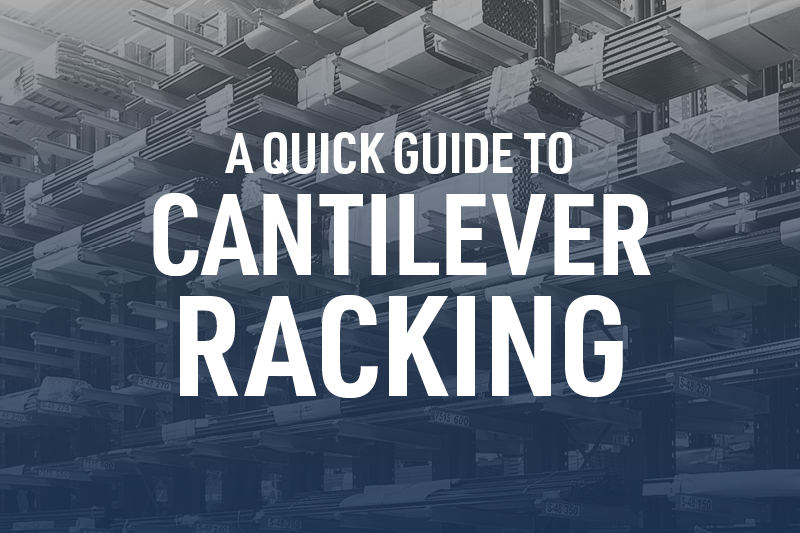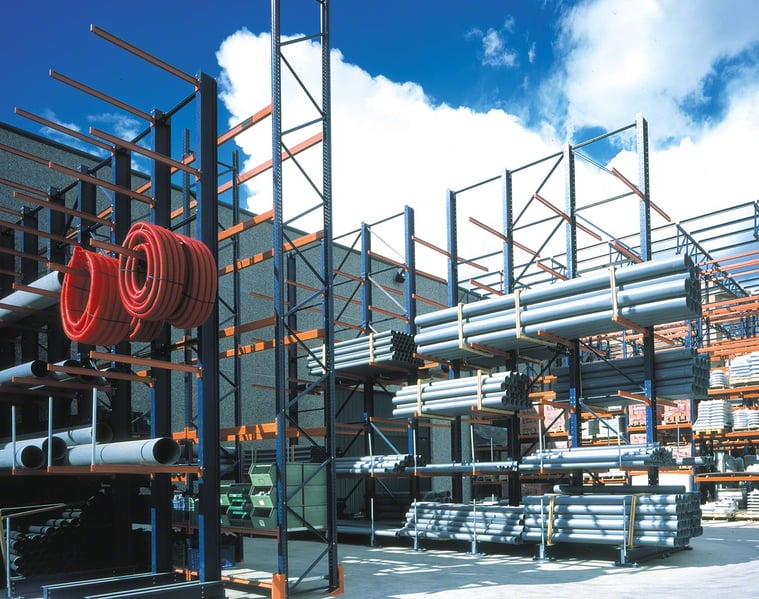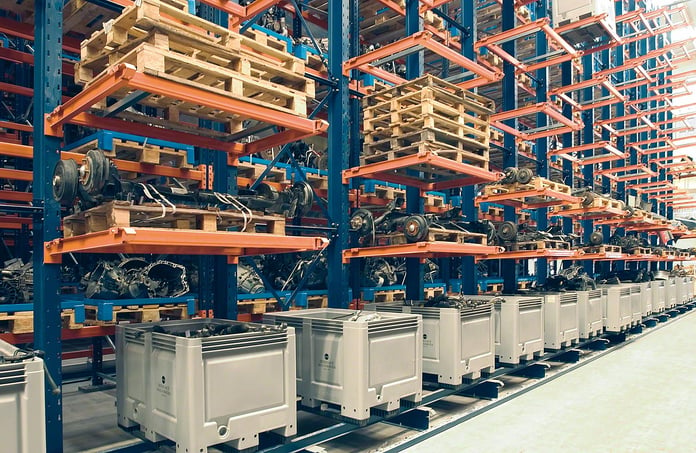
The trouble with a lot of storage is the assumption that everything fits into a carton or onto a pallet. So if you’re trying to store anything bigger than 48” x 40”, it can feel like forcing a round peg into a square hole. That’s where cantilever racking can be a real game changer.
This specialized racking is the perfect solution for most products that are just too big to fit traditional pallets. Whether you need heavy-duty sheet metal racks or outdoor pipe storage racks or furniture storage, cantilever racking might be the solution you’re looking for. Read on to learn more about cantilever racking and how to add it to your facility.
What Is Cantilever Racking?
Cantilever racking is a highly versatile racking system that efficiently stores bulky, non-palletized product. It’s a series of rear-mounted uprights that support arms where material, like sheet metal or long pipes, can be stored without having to fit between front-mounted uprights.
This racking system is made up of 4 different components which interact to create a durable storage solution for your oversized goods.
- Uprights. Uprights form the backbone of the system. These are typically made of heavy-duty steel and are designed to fit tiered levels of support arms. Uprights range in height from 8 to 20 ft.
- Arms. The arms support the product loaded onto the rack. They are formed by one of two manufacturing processes to create either structural arms or roll-formed arms. Each comes in 3 styles: straight, standard, and inclined. All are available in varying lengths.
- Bases. Because cantilever racks do not use front-mounted uprights, extended bases provide a stable foundation for this racking type. These bases are bolted to the floor and are at least as long as the arms used.
- Braces. Braces provide stability between uprights by connecting them together. These come in several options. X-braces are a common variety as they provide both diagonal and horizontal support.

Why Use Cantilever Racking?
For certain applications, cantilever racking offers distinct advantages over traditional pallet racking.
- Over-sized storage. Cantilever racking is ideal for storing bulky, long, or oddly shaped products.
- Heavy-duty. Due to its steel construction, cantilever racks can support heavier loads than standard pallet racking.
- Customizable. The simple design and structure of cantilever racking make it easy to adjust to fit unique storage needs.
- Increased storage density. Without cantilever racks, bulky products must be stored on the floor, which limits storage density. Cantilever racks allow vertical storage for these products, maximizing your warehouse space and avoiding a common warehouse design mistake.
- Durable. Cantilever racks are highly durable. Galvanized or powder-coated models are corrosion-resistant, making them excellent for outdoor storage.
Cantilever Racking vs. Pallet Racking
By description, cantilever racking and pallet racking might sound similar. However, several key differences between the two allow each to fit unique functions within a warehouse.
Pallet-Free
Generally, cantilever racking stores non-palletized products such as long pipes, sheet metal, and lumber. Additionally, the spacing between uprights is often wider than a standard pallet. Decking can be added to cantilever arms, allowing them to support pallets. However, this is typically an inefficient use of space and generally not recommended.
Half the Uprights
To support a pallet, pallet racks use 4 uprights. One supports each corner of the pallet. Cantilever racks support their loads with as little as 2 uprights. Both of these uprights are positioned at the back of the racking. This allows long goods to be loaded and unloaded without colliding with front-mounted uprights.
Pricing
Heavy-duty cantilever racks are built with heavy-gauge steel. This increases the cost of this type of racking, making it more expensive than traditional pallet racking.
How To Determine Cantilever Rack Capacity
Cantilever rack capacity depends on equal distribution of weight between the arms. Each arm is rated by the manufacturer to support an approximate weight. For example, standard 48x4 arms are typically rated for 2,000 lbs. So if your load weighs 6,000 lbs, you’ll need at least 3 arms to support it.
Likewise, cantilever uprights are also rated to a maximum weight. This weight rating references the total weight support by each arm attached to the upright. Thus, the total each arm can actually support will be affected by the number of arms on the upright.
For example, let's say you have an upright rated for 10,000 lbs, and you're using the same 48x4 arms mentioned above. That means for a single-sided cantilever rack with 5 arms, each arm can support close to its rated load of 2,000 lbs. However, if your rack is double-sided, you now have 10 arms on that upright. This means that each arm can only support 1,000 lbs, despite their 2,000 lbs rating.
Other Capacity Considerations
Other factors can influence cantilever rack capacity. Arm type, for example, affects these calculations. Structural arms will support a little more than their rated capacity, but roll-formed might support a little less than their rating. Similarly, bracing between uprights can increase the total load rating of each upright in the rack.
Cantilever Rack Installation Considerations
Cantilever racking uprights are installed based on the product they're intended to hold. Uprights are spaced so arms support loaded materials evenly without allowing the product to sag in the middle.
Product will hang over the outside arms laterally but should not hang out on either end more than half the distance between uprights. For example, if there is 4 feet between your uprights, the loaded product should not hang more than 2 feet over the outside arms.
Rack Configurations
Cantilever racking can be installed in two configurations: single-sided and double-sided. Single-sided cantilever racking only has arms on one side of the upright. This configuration is best suited for installation against a wall or similar barrier. Double-sided racking has arms on either side of each upright. This is best for in-aisle use.
Aisle Sizing
Due to the size of products stored on cantilever racks, aisle width is usually wider than aisles between traditional pallet racks. This is to ensure forklifts have room to maneuver with long loads. The use of specialized forklifts like a COMBiLift can reduce the required width of aisles.
Customized Racking Solutions
If your warehouse stores long, oversized, or bulky products, cantilever racking might be the perfect choice for your storage needs. However, these are not a one-size-fits-all solution. Each type of racking excels at a particular kind of storage. So let us help you find the right integrated storage solution for your facility. Our warehouse solutions team has the expertise you need to get the most out of your storage space. To learn more or set up your consultation, contact us online or visit one of our Mid-South locations:
Arkansas - Jonesboro
Alabama - Birmingham, Dothan, Irondale, Madison, Mobile, and Montgomery
Mississippi - Tupelo and Richland
Tennessee - Jackson, Memphis, Knoxville, and Kingsport
Further Reading
8 Expensive Warehouse Design Mistakes
Different Types of Pallet Racking
5 Things A COMBiLift Can Do That Other Forklifts Can’t
Posts by Tag
- Forklift (61)
- Forklift Service (19)
- Electric Forklifts (16)
- Forklift Safety (14)
- Forklift Attachments (12)
- Toyota Forklifts (12)
- Warehouse Planning (10)
- Parts (9)
- Warehouse Automation (8)
- Clark Forklifts (7)
- Loading Docks (7)
- Material Handling Education (7)
- Pallet Racking (7)
- Customer Solutions (6)
- Forklift Batteries (6)
- Forklift Rental (6)
- Purchasing Options (6)
- Aerial Equipment (5)
- Heavy Equipment (5)
- Forklift Accessories (4)
- Forklift Fleet Management (4)
- Forklift Tires (4)
- Forklift Training (4)
- Products (4)
- Utility Vehicles (4)
- Yard Spotter Trucks (4)
- Linde (3)
- Pallet Jacks (3)
- Specialty Forklifts (3)
- Used Equipment (3)
- IC Forklifts (2)
- Manitou (2)
- Warehouse Doors (2)
- COMBiLift (1)
- Custom Shop (1)
- Forklift Brakes (1)
- Forklift Warranty (1)
- Gehl (1)
- Komatsu (1)
- Product Review (1)
- Recruitment (1)












